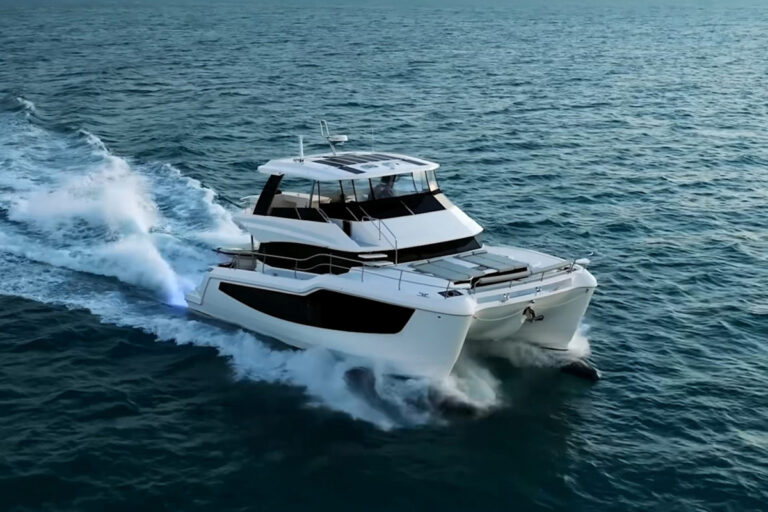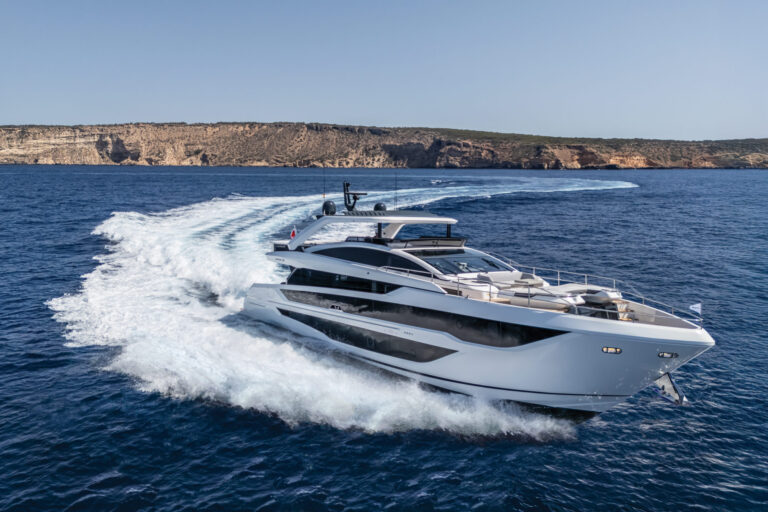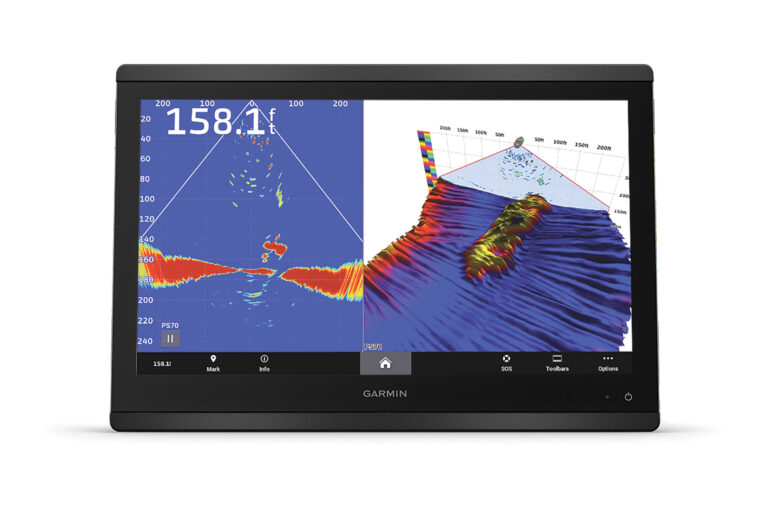The best way to evaluate a new fishboat design is to spend time aboard her fishing. At least that was my excuse when I accepted an invitation from Hatteras Yachts to chase sailfish in the Florida Keys. While the fishing wasn’t red-hot, the new 68 Convertible is. Once again Hatteras has returned to its roots and nudged the market it helped to create forward. The result will gladden the hearts of all boaters.
Hatteras’ tournament team, Capt. Terry Stansel and his wife Bonny, greeted me. While Stansel makes moving the 68 look effortless, her generous allotment of power reduces the challenge significantly. After a twist or two in the marina we passed the endpin and aimed the 68 offshore. Loafing along at 27 knots we were on the edge of the reef in minutes. Fishing had been slow, but we were hopeful as a cold front was pushing though-the kite was launched and the bait set.
The 68’s 192-square-foot teak-soled cockpit is large even for a boat her size. Though we were a group of anxious anglers stand-up fishing, there was plenty of room to move about. For larger game, a Pompanette fighting chair with an offset pedestal keeps the angler in the boat and the rod tip close to the transom. There are two in-sole fishboxes, one of which was plumbed to an ice machine. Those not in the fray relaxed on the mezzanine deck two steps above the cockpit. The modular seating can be arranged to suit a client’s angling style with storage, a live well, a freezer and bait prep center. There is also a freezer on the bridge.
Kite fishing is a sport for the patient, as one more or less wafts along with the current using the engines to keep the kite in position. The 68 provided a stable platform and with electronic low-idle and trolling valves she can loiter at a snail’s pace. The helm seating offers a clear view of the cockpit and the pop-up electronics console. There is observer seating aft and a lounge area forward.
As the fish seemed uncooperative, after a while we decided to pull in the lines and go back to work-I still had a sea trial to complete. To the knowledgeable eye the 68’s specifications and her performance data offer more than a hint as to the way she feels at sea. A boat with a 21-foot, 6-inch beam weighing 126,500 pounds cruising at more than 30 knots has a lot going for it in terms of inertia. The 68 is a powerful ride and while the seas were relatively tame on our trial I can promise you little will slow her down. This brutish sense of strength is enhanced by deep reduction gearing (4.1:1) and a pair of 49-inch x 85-inch seven-blade wheels that transmit horsepower into thrust.
While deep reductions and large wheels typically increase draft, the Hatteras design team has negated this penalty with a unique hull form and relatively deep propeller tunnels. Multiple longitudinal ledges above her chine trim her full-bodied topsides to a planing surface suited to her loading. Forward, her sections are deep and slightly convex-ideal for softening head seas. Her small keel deepens aft and deadrise moderates from 20 degrees amidships to just 2 degrees at the transom. Her flatter after sections stiffen her motion at rest in a beam sea and create an extremely efficient lifting surface at speed. While more deadrise is typical for a boat of her size and speed, I believe the magic of the 68’s performance is the combination of her form and her mass.
While the 68 has a muscular feel she is agile and quick to respond. She banks predictably into turns and tracks well. Her trim tabs are fitted at the after ends of her propeller tunnels. By taking advantage of the propeller thrust, less tab area and travel is required. I found little need for the tabs given the sea conditions and our loading during the sea trial. After a rather civil stint at the tournament-style helm pod, I turned the 68 over to Stansel who knows her well and was anxious to demonstrate her capability. Massaging her single-lever controls, he spun her around as though she were a 40-footer. He then backed her down at what I estimated to be a solid 10 knots-very, very impressive. This is a nimble yacht.
Hull number one is fitted with a pair of Caterpillar C32 ACERTs (Advanced Combustion Emission Reduction Technology). Cat’s reengineering of its proven V-12 platform has resulted in a cleaner, more efficient engine and a new rating of 1,800 hp. This makes the C32 ACERT an ideal choice for the 68. During our sea trial I recorded a maximum speed of 32.6 knots at 2330 rpm. At 2100 rpm she cruises at 29.4 knots and I noted a fuel burn of 146 gph; 2,000 hp, MTU 16V-2000s are also offered.
Hatteras has always led the industry in terms of system design and installation and the 68 is an example of the reason why. Her faired and finished, high-gloss machinery space is custom-like in its presentation. Piping and wiring travel well-thought-out routes and service points are within easy reach. Cockpit access leads to the engineroom and a machinery space on centerline beneath the cockpit. An underwater exhaust system with a transom bypass reduces the ‘station wagon effect’ common on convertibles. An engineroom plenum system draws combustion air from beneath the cockpit coaming, eliminating the need for hullside vents and increasing the opportunity to separate air and water. Fresh thinking indeed for a conservative builder!
Given the 68’s displacement, Hatteras’ reputation for building a stout boat is clearly intact. While other production builders have fiddled with lightweight structures, Hatteras has always favored practical and proven methods. The 68’s hull bottom is solid fiberglass supported by a fiberglass stringer system and Divinycell foam-cored bulkheads. Coring is used to stiffen the hullsides, decks and superstructure. Like all Hatteras yachts, the 68’s molded gelcoat finish is prepped and painted in a state-of-the-art coating facility. In recent years Hatteras has been using Awlcraft 2000. Fuel tankage is UL approved and built of fiberglass. The bottom laminate includes a skin coat of vinylester and an epoxy barrier coat that is applied before the bottom paint.
By coining the term ‘convertible’ to describe its first product in 1960, Hatteras understood that fishing was a lot more fun when those aboard were comfortable. The 68 takes this theme to a new level thanks to her interior volume-she is actually beamier than the builder’s 90-foot Convertible. An air-actuated sliding door leads from the cockpit to the open main cabin. A saloon area aft has sofa-style seating positioned to take advantage of a 42-inch plasma TV. The galley area has under-counter refrigeration and is steps away from a dinette. Below, the four-stateroom/four-head layout includes a full-beam master stateroom amidships, with a king-size berth and a walk-in, cedar-lined hanging locker. There is a VIP stateroom with an island berth forward; a starboard guest stateroom has side-by-side berths, a portside crew cabin offers upper and lower berths. Cherry-wood joinery with a satin or high-gloss finish is standard and variations on the layout, including an enclosed bridge, are offered.
While Hatteras’ lineup of fishboats ranges from 50 to 90 feet, the 68 seems to be right on target for today’s market in terms of comfort, performance and capability. She’s not so large that a day trip chasing sailfish is a hassle. On the other hand, she’s got the legs necessary to follow fish beyond our boarders. As I write, the Hatteras fishing team is doing just that in Mexico. I wish I were there!
Contact: Hatteras Yachts, (252) 634-4895; www.hatterasyachts.com_._








